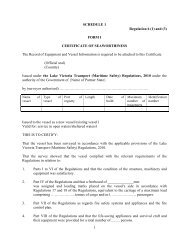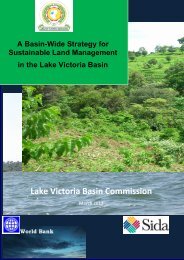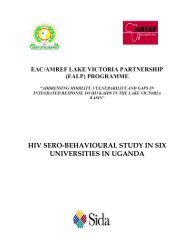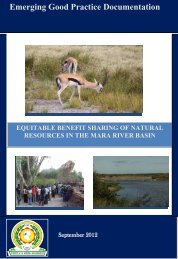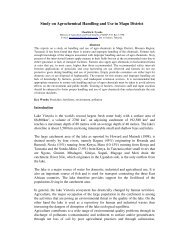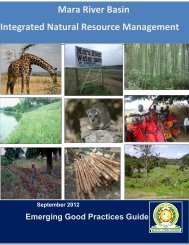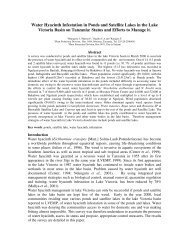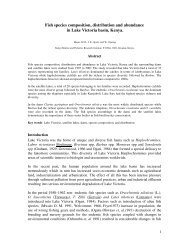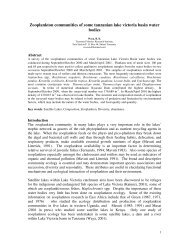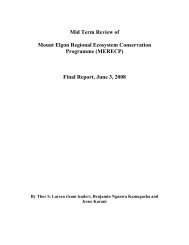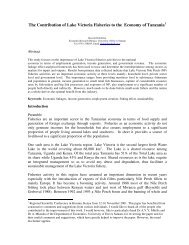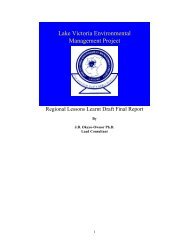Total Economic Value of Maasai Mau, Trans Mara and Eastern Mau ...
Total Economic Value of Maasai Mau, Trans Mara and Eastern Mau ...
Total Economic Value of Maasai Mau, Trans Mara and Eastern Mau ...
You also want an ePaper? Increase the reach of your titles
YUMPU automatically turns print PDFs into web optimized ePapers that Google loves.
<strong>Economic</strong> valuation <strong>of</strong> forest goods <strong>and</strong> services is based on the notion <strong>of</strong> willingness topay that assesses individual preferences. Willingness to pay is determined bymotivation, which may vary from pure self-interest to altruism, concern for futuregenerations <strong>and</strong> environmental stewardship. Survey techniques in environmentaleconomics reveal that motivations vary significantly between individuals, but that selfinterestis only one <strong>of</strong> many motives for environmental valuation. Market prices reflectwillingness to pay. Because some consumers are willing to pay more than the price<strong>of</strong>fered by the market, there is always a consumer surplus in market transactions.The types <strong>of</strong> economic value to be found in forests are use values <strong>and</strong> non-use values. Usevalues refer to willingness to pay to make use <strong>of</strong> forest goods <strong>and</strong> services. Such usesmay be direct, e.g. extractive uses or indirect, e.g. watershed protection or carbon storage.Use values may also contain option values, willingness to pay to conserve the option forfuture use even though no use is made <strong>of</strong> the forest now. Such options may be retainedfor one’s own use or for another generation (sometimes called a ‘bequest’ value). Nonusevalues relate to willingness to pay, which is independent <strong>of</strong> any use made <strong>of</strong> theforest now or any use in the future. The sum <strong>of</strong> individual use <strong>and</strong> non-use values is thetotal economic value.1.4 Significance <strong>of</strong> the Valuation StudyThe development challenge facing the <strong>Mara</strong> River Basin includes raising the livingst<strong>and</strong>ards <strong>of</strong> the local communities while reversing degradation <strong>and</strong> depletion <strong>of</strong>natural resources so as to guarantee similar or better living st<strong>and</strong>ards for futuregenerations. The valuation process <strong>of</strong> the forest ecosystem is critical to identifying themain beneficiaries, cost bearers, the magnitude <strong>of</strong> benefits <strong>and</strong> costs, funding sources,equity <strong>and</strong> even gender issues. The distribution <strong>of</strong> benefits from forest products exhibitsan inequitable situation. Local communities bear the brunt <strong>of</strong> forest degradation whilepopulations living further away from forests, tourists, city-dwellers <strong>and</strong> industries <strong>of</strong>tenbenefit the most from forest goods <strong>and</strong> services free <strong>of</strong> charge or for very low prices.Valuation <strong>of</strong> forest resources <strong>and</strong> analysis <strong>of</strong> benefit distribution help to equitablyapportion the cost <strong>of</strong> forest conservation among the stakeholders, <strong>and</strong> provide themwith incentives to conserve forests, to limit their consumption <strong>of</strong> forest resources tosustainable levels, to halt forest clearance for other economic activities <strong>and</strong> to exploitforest resource sustainably. In spite <strong>of</strong> their central role in conservation <strong>of</strong> forestresources, government departments seldom raise adequate funds to administer theforests effectively.15



